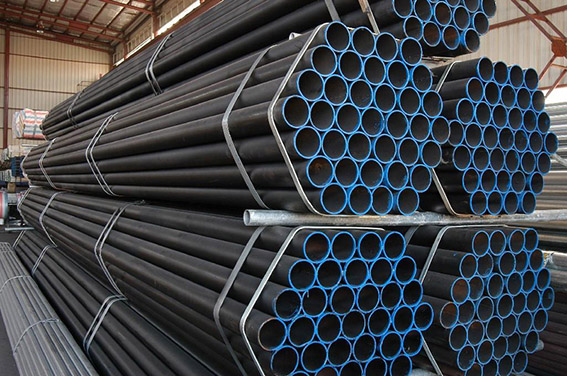What Is Black Steel Pipe and How Is It Used?
Understanding the Basics of Black Steel Pipe
Due to its strength, durability, and price, black steel pipe is widely used in many industries. As its name suggests, black steel pipe is made from steel that hasn’t been galvanized; the dark colored iron oxide coating that forms during manufacturing gives the pipe its name. The pipe is produced by rolling steel sheets into a seamless tube or welding them together. The integrity and performance of the pipe is reliable even under demanding conditions. This type of pipe is known for effortlessly handling high pressure and is vibration-resistant and resistant to heavy load damage.
For more in-depth information, you should view the Black Steel Pipe – BALING STEEL
Common Uses of Black Steel Pipe
Black steel pipe is applicable in many areas. In the construction sector, it is one of the most basic pipes that transports gas and water to houses and other buildings, both domestic and commercial. Due to its industrial-grade strength, black pipe is suitable for transporting flammable gases, including propane and natural gas in industries. It is also used in fire sprinkler systems because it able to withstand elevated temperatures. Its strength also makes it useful in oil and petroleum pipelines. Beyond industrial usage black steel pipe is becoming popular in contemporary architectural and furniture design for its industrial look tempered with practicality.
View Black Steel Pipe – BALING STEEL for More Details
Ways in Which Black Steel Pipe is Different from Other Pipe Types
One of the protective coatings distinguishing black steel pipe from other categories, like galvanized steel or even stainless steel, is its protective coating. Unlike galvanized steel, which has a layer of zinc added to it for anti-corrosion purposes, black steel pipe lacks this protective layer, which allows it to readily rust if exposed to moisture. This downside allows black steel pipe to be more affordable, effortless to coat, and easier to weld for certain bespoke applications. In comparison to stainless steel, black steel pipe remains weaker in terms of corrosion resistance but gains an advantage in strength and price in projects where corrosion resistance isn’t a critical concern. These differences must be understood to choose the appropriate material for a certain project or application.
How to Choose the Right Size and Schedule for Black Pipes?
Determining the Inside Diameter and Nominal Pipe Sizes
In the case of black steel pipes, their compatibility and functionality begin with identifying the inside diameter (ID). The measurement of the hollow portion of a pipe is called ID, where the flow of substances, liquids, and gases is channeled through. NPS or nominal pipe size is a method of pipe measurement in the industry that encompasses outside diameter (OD) and wall thickness. Caring wall thickness is required while measuring nominal size and inside diameter, since they may not perfectly align.
Understanding Schedule 40 Black Pipe Specifications
A Schedule 40 pipe is widely used and common among black steel piping due to its range of applications. Its strong yet lightweight nature makes it very adaptable to moderate, pressure-dependent usages such as structural support systems. The number designated for the schedule indicates the wall thickness, which is directly proportional to the pipe’s inside diameter. For instance, a Schedule 40 pipe with a 1 inch NPS will have specific industry standards set for the inside and outside measurements. Knowing the Schedule 40 specifications will help determine if the pipe will be appropriate for your project’s pressure and flow needs.
Considerations that Influence Pipe Size in a DIY Project
DIY pipe size selection requires careful thought concerning a range of factors like the type of material being transported and the flow rate desired. Higher stress projects will likely require larger diameter and thicker wall pipes (Schedule 80) compared to fluid transport projects, which are primarily concerned with flow. The pipes’ ease of installation, exposure to environmental conditions, and compatibility with fittings are also relevant. An in-depth evaluation of the previously mentioned factors ensures that the selected pipe size is optimal for the project.
What Are the Benefits and Drawbacks of Using Black Steel Pipe?
Advantages of Black Steel Pipe in Construction and Plumbing
Due to its strength, durability, and versatility, black steel pipe is widely used in construction and plumbing applications. The robust structure of the pipe makes it highly resistant to high pressures. Such characteristics are essential in transporting gases and fluids safely across industrial and residential systems. Besides, black steel pipe has a non-coated surface, which allows it to withstand high heat levels, making it perfect for use in applications such as fire sprinkler systems and gas pipelines. Compared to other materials, black steel pipe is also cost-effective. The steel offers a reliable yet economical solution for various projects. In addition, black steel pipe has threads and welded joints, which makes the installations easy, further reducing labor time and costs.
Possible Shortcomings and Constraints of Black Steel Pipe
The limitations of black steel pipe, as with anything, must be approached with cautious consideration. Its effective uses and benefits do not eliminate the concern of a lack of protective coating, which increases the corrosion rate, especially when moisture and water are present. This renders it impractical for some locations, such as outdoors or under the ground, where the lifespan would greatly suffer. This vulnerability requires additional spending and anti-corrosion treatment,s which would increase the overall budget for the initiative. Furthermore, heavy black steel pipes add to the expenses and difficulty to large projects due to the burdensome issues of transportation and installation. Lastly, the potential risk of rust, along with contaminants slowly building over time, makes black steel pipes hazardous for storing drinkable water. It is best to accept and understand these limitations so that black steel pipes can be used for the right purposes and within the right conditions.
How Does Black Steel Pipe Compare to Other Metal Pipes?
Comparing Black Steel and Galvanized Pipe
Both black steel and galvanized pipes have a wide use in construction and industrial activities, which is why they are usually compared, but the two serve different functions. Black steel pipes have no coating or treatment, which makes them perfect for use in transporting gas, fire sprinkler systems, and several other uses where corrosion does not matter. Conversely, galvanized pipes have a coat of zinc to prevent corrosion, which makes them ideal for plumbing and water transport in places where this water is abundant. The added zinc coating, however, increases the cost of galvanized pipes and may also introduce challenges in welding and modifying the material.
Analyzing the Distinctions Between Black Iron and Cast Iron Pipes
It is important to recognize that black iron and cast iron pipes serve different structural and functional purposes. Where black steel piping serves its purpose for gas distribution, it is often referred to as black iron piping. Black steel has a higher tensile strength compared to all other types of steel, making black iron pipes very useful in piping gas systems. In its various forms, cast iron has lower tensile strength, which makes it very brittle, but it is also very rigid, which makes it useful for underground sewage systems where compressive strength is a necessity. The properties of cast iron make certain projects where vibration resistance or noise dampening is necessary efficient.
Considering Black Steel Pipe and Other Metals for Your Use
Every project will be uniquely different, and so will every piping material tailored specifically for it. Black steel offers strength and structural integrity while being economical for use in gas and fluid transport under high pressure. In cases where there is high exposure to moisture or potable water, galvanized steel, copper, or even stainless steel would outperform due to higher corrosion resistance and safety standards. In addition, modern-day materials such as PEX (cross-linked polyethylene) and CPVC (chlorinated polyvinyl chloride) are appealing on account of their toughness as well as being resistant to corrosion, for both residential and industrial purposes. In the end, the most prudent approach considers these diverse but interrelated factors: expenses, maintenance costs, and operational environment alongside abiding by local laws.
What Are the Installation Tips for Black Steel Pipe?
Tips for Cutting and Joining Black Steel Pipe
Achieving a safe and operational black steel pipe installation requires appropriate precision tools during the cutting and joining processes. A rotary pipe cutter or a metal reciprocating saw will achieve the desired cut. Prior to cutting pipe, measurements must be taken and appropriately marked to reduce material wastage. Cut edges may be smoothed with a deburring tool or file, which reduces, but does not eliminate, seams, preventing leaks while enhancing the fit of fittings. For assembly, pipe thread sealant should be applied in addition to Teflon tape, which assists in preventing leaks. Threaders should fashion with the right size to match the pipes being joined for seamless attachment. It is good practice to perform pressure tests afterward to ensure the connections are maintained properly.
Instructions on The Use of Black Iron Fittings
These types of black iron fittings must be used with black steel pipes in applications such as gas distribution and fire sprinkler systems. A good quality black iron fitting must constantly resist wear and tear, corrosion, and destruction in the environment. The fitting must also be of the same pipe size and thread pattern to have a secure fit. With respect to installation, the proper wrenches need to be used to tighten the fitting without using too much force so as not to destroy the threads or structural components. Always follow the manufacturer’s suggestions for fitting operating pressure and temperature limits.
Application Instructions: Checking the Wall Thickness and Coat
With respect to wall thickness or schedule selection, it has to ensure that the requirements of pressure and temperature constraints are met. For high-pressure systems, Schedule 40 or Schedule 80 pipes are often appropriate, while lighter ones may be fine for lower pressure. Also, make sure that the pipes possess a proper protective coating to guard against external corrosion for outdoor or humid environments. Make sure all the outdoor or working surfaces of the pipes and coatings are devoid of any scratches and if they are, touch them up with anti-corrosion paint where needed. Following these set criteria enhances the system’s life and performance.
Can Black Steel Pipe Be Used in DIY and Home Improvement Projects?
Exploring DIY Applications of Black Steel Pipe
Due to its strength, resilience, and bold industrial look, black steel pipe is a material that can be found and put to use in numerous DIY and home improvement projects. This material is quite common in the plumbing and construction industries, but its custom furniture-shelving units and decor pieces have further augmented its popularity. The black color of the pipes works great with contemporary and antique décor, which is why the pipe is loved by DIYers who prioritize effectiveness and beauty.
Project Ideas for Using Black Steel Pipe at Home
There are plenty of projects where black steel pipe could improve both the style and usefulness of a home:
Industrial Pipe shelves – Industrial style shelving can be created by combining wooden planks with black steel pipes, which form the bracket. These shelves can hold books, decorative pieces, or even functional storage in bathrooms and kitchens.
Custom furniture – Make custom pieces like tables and chairs by using black steel pipe as the frame anda wooden or metal top for added contrast.
Clothing racks – Durable yet fashionable open wardrobe systems or clothing racks can be made using black steel pipes, all while incorporating industrial style.
Lighting fixtures – Black steel pipe can be used to make lamps and pendant lights, which add an industrial feel to any place.
Home gym equipment – Cost-effective gym gear, such as pull-up bars, squat racks, and weight storage, can be made using black steel pipes as they are inexpensive.
Considerations for Using Black Pipe in a Home System
While black steel pipe is quite long-lasting, it needs certain precautions when used in home projects:
Corrosion resistance – Black steel pipes do not naturally come rust-proof. They will need to be sealed or painted to prevent corrosion, especially in outdoor or humid areas.
Weight – Its material constraints, therefore, the walls or supporting structures must be reinforced to carry the weight. Stability may require the use of anchors and brackets.
Safety – If the pipe is part of load-bearing structures, its safety and reliability are ensured through proper inspection and measurement.
Threading and Fittings– Proper threading and compatible fittings are needed to make secure joints on black steel pipe, which is often necessary. Check all of the notifications to ensure there is no mismatch that will cause a structural failure.
Knowing the uses of black steel pipe together with its properties enables the homeowner and any DIY projects to take advantage of its aesthetic appeal and durability, tailored to long-lasting impact projects.



































